HRM Report: Evaluating Human Resource Management Practices
VerifiedAdded on 2022/09/29
|13
|3492
|26
Report
AI Summary
This report provides a comprehensive overview of Human Resource Management (HRM), exploring its purpose and scope within an organization, with a focus on resourcing. It delves into the functions of HRM, including training and development, employee relations, and maintaining a healthy workplace environment. The report examines recruitment and selection processes, contrasting internal and external approaches and evaluating their respective advantages and disadvantages. It also analyzes different selection methods such as application forms and employment interviews. Furthermore, the report differentiates between 'best fit' and 'best practice' approaches, and evaluates the effectiveness of key HRM elements, including hard and soft HRM. The importance of training, development, and employee motivation is highlighted, along with an analysis of internal and external factors influencing HRM decisions and the significance of employee relations and employment laws. The report concludes with an application of HRM practices, providing a holistic understanding of the subject.

HUMAN RESOURCE
MANAGEMENT
MANAGEMENT
Paraphrase This Document
Need a fresh take? Get an instant paraphrase of this document with our AI Paraphraser
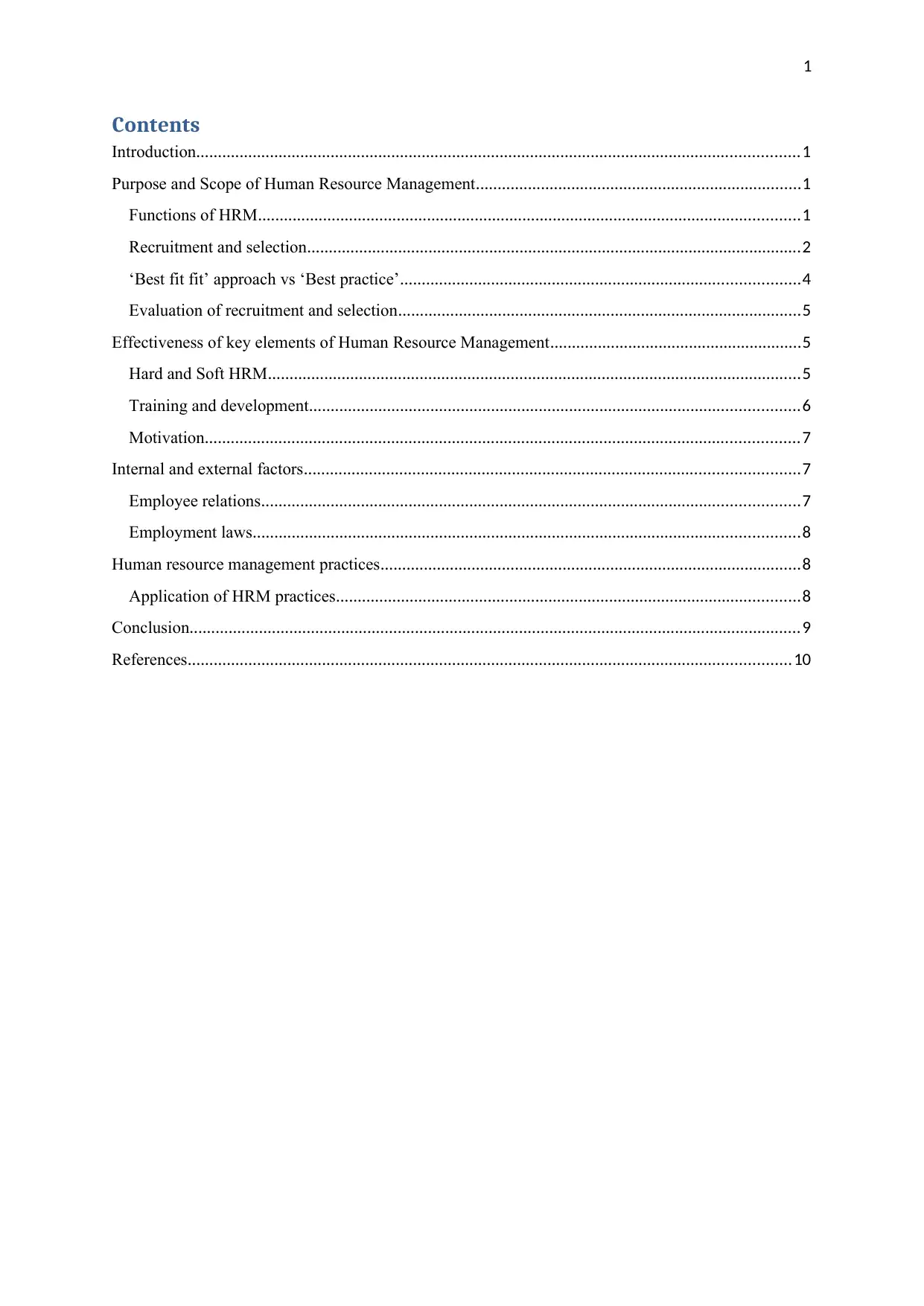
1
Contents
Introduction...........................................................................................................................................1
Purpose and Scope of Human Resource Management...........................................................................1
Functions of HRM.............................................................................................................................1
Recruitment and selection..................................................................................................................2
‘Best fit fit’ approach vs ‘Best practice’............................................................................................4
Evaluation of recruitment and selection.............................................................................................5
Effectiveness of key elements of Human Resource Management..........................................................5
Hard and Soft HRM...........................................................................................................................5
Training and development.................................................................................................................6
Motivation.........................................................................................................................................7
Internal and external factors..................................................................................................................7
Employee relations............................................................................................................................7
Employment laws..............................................................................................................................8
Human resource management practices.................................................................................................8
Application of HRM practices...........................................................................................................8
Conclusion.............................................................................................................................................9
References...........................................................................................................................................10
Contents
Introduction...........................................................................................................................................1
Purpose and Scope of Human Resource Management...........................................................................1
Functions of HRM.............................................................................................................................1
Recruitment and selection..................................................................................................................2
‘Best fit fit’ approach vs ‘Best practice’............................................................................................4
Evaluation of recruitment and selection.............................................................................................5
Effectiveness of key elements of Human Resource Management..........................................................5
Hard and Soft HRM...........................................................................................................................5
Training and development.................................................................................................................6
Motivation.........................................................................................................................................7
Internal and external factors..................................................................................................................7
Employee relations............................................................................................................................7
Employment laws..............................................................................................................................8
Human resource management practices.................................................................................................8
Application of HRM practices...........................................................................................................8
Conclusion.............................................................................................................................................9
References...........................................................................................................................................10
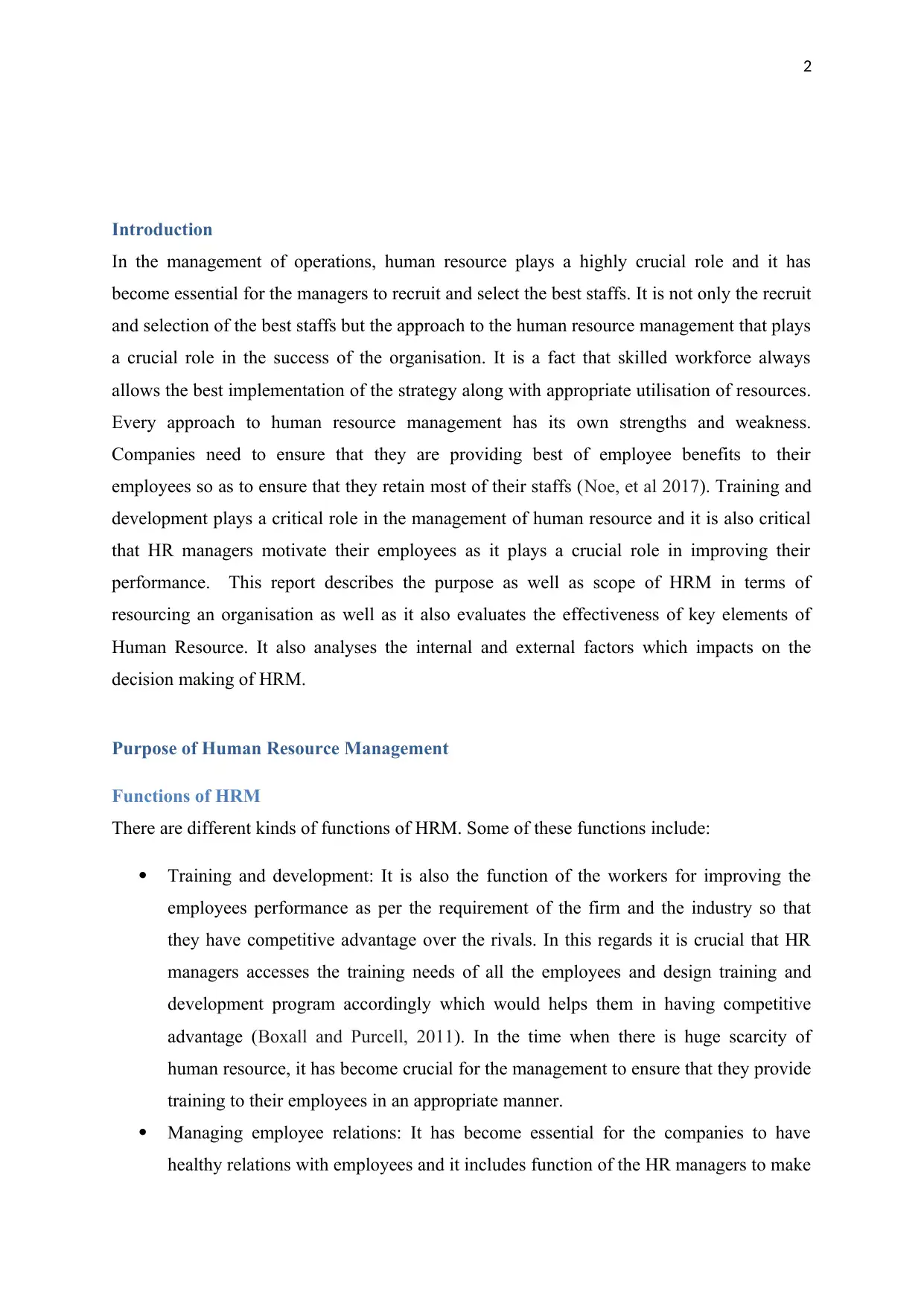
2
Introduction
In the management of operations, human resource plays a highly crucial role and it has
become essential for the managers to recruit and select the best staffs. It is not only the recruit
and selection of the best staffs but the approach to the human resource management that plays
a crucial role in the success of the organisation. It is a fact that skilled workforce always
allows the best implementation of the strategy along with appropriate utilisation of resources.
Every approach to human resource management has its own strengths and weakness.
Companies need to ensure that they are providing best of employee benefits to their
employees so as to ensure that they retain most of their staffs (Noe, et al 2017). Training and
development plays a critical role in the management of human resource and it is also critical
that HR managers motivate their employees as it plays a crucial role in improving their
performance. This report describes the purpose as well as scope of HRM in terms of
resourcing an organisation as well as it also evaluates the effectiveness of key elements of
Human Resource. It also analyses the internal and external factors which impacts on the
decision making of HRM.
Purpose of Human Resource Management
Functions of HRM
There are different kinds of functions of HRM. Some of these functions include:
Training and development: It is also the function of the workers for improving the
employees performance as per the requirement of the firm and the industry so that
they have competitive advantage over the rivals. In this regards it is crucial that HR
managers accesses the training needs of all the employees and design training and
development program accordingly which would helps them in having competitive
advantage (Boxall and Purcell, 2011). In the time when there is huge scarcity of
human resource, it has become crucial for the management to ensure that they provide
training to their employees in an appropriate manner.
Managing employee relations: It has become essential for the companies to have
healthy relations with employees and it includes function of the HR managers to make
Introduction
In the management of operations, human resource plays a highly crucial role and it has
become essential for the managers to recruit and select the best staffs. It is not only the recruit
and selection of the best staffs but the approach to the human resource management that plays
a crucial role in the success of the organisation. It is a fact that skilled workforce always
allows the best implementation of the strategy along with appropriate utilisation of resources.
Every approach to human resource management has its own strengths and weakness.
Companies need to ensure that they are providing best of employee benefits to their
employees so as to ensure that they retain most of their staffs (Noe, et al 2017). Training and
development plays a critical role in the management of human resource and it is also critical
that HR managers motivate their employees as it plays a crucial role in improving their
performance. This report describes the purpose as well as scope of HRM in terms of
resourcing an organisation as well as it also evaluates the effectiveness of key elements of
Human Resource. It also analyses the internal and external factors which impacts on the
decision making of HRM.
Purpose of Human Resource Management
Functions of HRM
There are different kinds of functions of HRM. Some of these functions include:
Training and development: It is also the function of the workers for improving the
employees performance as per the requirement of the firm and the industry so that
they have competitive advantage over the rivals. In this regards it is crucial that HR
managers accesses the training needs of all the employees and design training and
development program accordingly which would helps them in having competitive
advantage (Boxall and Purcell, 2011). In the time when there is huge scarcity of
human resource, it has become crucial for the management to ensure that they provide
training to their employees in an appropriate manner.
Managing employee relations: It has become essential for the companies to have
healthy relations with employees and it includes function of the HR managers to make
⊘ This is a preview!⊘
Do you want full access?
Subscribe today to unlock all pages.

Trusted by 1+ million students worldwide
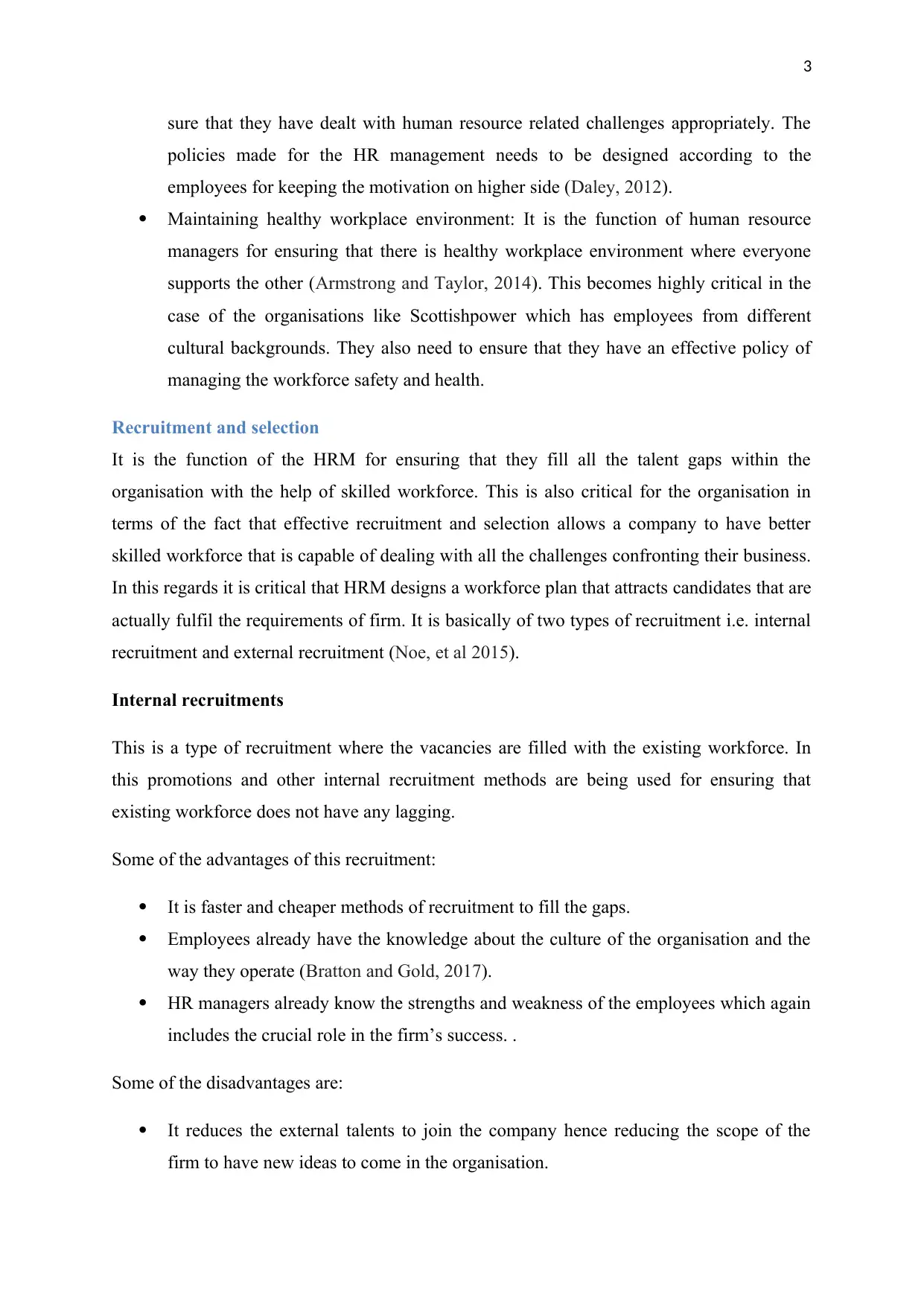
3
sure that they have dealt with human resource related challenges appropriately. The
policies made for the HR management needs to be designed according to the
employees for keeping the motivation on higher side (Daley, 2012).
Maintaining healthy workplace environment: It is the function of human resource
managers for ensuring that there is healthy workplace environment where everyone
supports the other (Armstrong and Taylor, 2014). This becomes highly critical in the
case of the organisations like Scottishpower which has employees from different
cultural backgrounds. They also need to ensure that they have an effective policy of
managing the workforce safety and health.
Recruitment and selection
It is the function of the HRM for ensuring that they fill all the talent gaps within the
organisation with the help of skilled workforce. This is also critical for the organisation in
terms of the fact that effective recruitment and selection allows a company to have better
skilled workforce that is capable of dealing with all the challenges confronting their business.
In this regards it is critical that HRM designs a workforce plan that attracts candidates that are
actually fulfil the requirements of firm. It is basically of two types of recruitment i.e. internal
recruitment and external recruitment (Noe, et al 2015).
Internal recruitments
This is a type of recruitment where the vacancies are filled with the existing workforce. In
this promotions and other internal recruitment methods are being used for ensuring that
existing workforce does not have any lagging.
Some of the advantages of this recruitment:
It is faster and cheaper methods of recruitment to fill the gaps.
Employees already have the knowledge about the culture of the organisation and the
way they operate (Bratton and Gold, 2017).
HR managers already know the strengths and weakness of the employees which again
includes the crucial role in the firm’s success. .
Some of the disadvantages are:
It reduces the external talents to join the company hence reducing the scope of the
firm to have new ideas to come in the organisation.
sure that they have dealt with human resource related challenges appropriately. The
policies made for the HR management needs to be designed according to the
employees for keeping the motivation on higher side (Daley, 2012).
Maintaining healthy workplace environment: It is the function of human resource
managers for ensuring that there is healthy workplace environment where everyone
supports the other (Armstrong and Taylor, 2014). This becomes highly critical in the
case of the organisations like Scottishpower which has employees from different
cultural backgrounds. They also need to ensure that they have an effective policy of
managing the workforce safety and health.
Recruitment and selection
It is the function of the HRM for ensuring that they fill all the talent gaps within the
organisation with the help of skilled workforce. This is also critical for the organisation in
terms of the fact that effective recruitment and selection allows a company to have better
skilled workforce that is capable of dealing with all the challenges confronting their business.
In this regards it is critical that HRM designs a workforce plan that attracts candidates that are
actually fulfil the requirements of firm. It is basically of two types of recruitment i.e. internal
recruitment and external recruitment (Noe, et al 2015).
Internal recruitments
This is a type of recruitment where the vacancies are filled with the existing workforce. In
this promotions and other internal recruitment methods are being used for ensuring that
existing workforce does not have any lagging.
Some of the advantages of this recruitment:
It is faster and cheaper methods of recruitment to fill the gaps.
Employees already have the knowledge about the culture of the organisation and the
way they operate (Bratton and Gold, 2017).
HR managers already know the strengths and weakness of the employees which again
includes the crucial role in the firm’s success. .
Some of the disadvantages are:
It reduces the external talents to join the company hence reducing the scope of the
firm to have new ideas to come in the organisation.
Paraphrase This Document
Need a fresh take? Get an instant paraphrase of this document with our AI Paraphraser
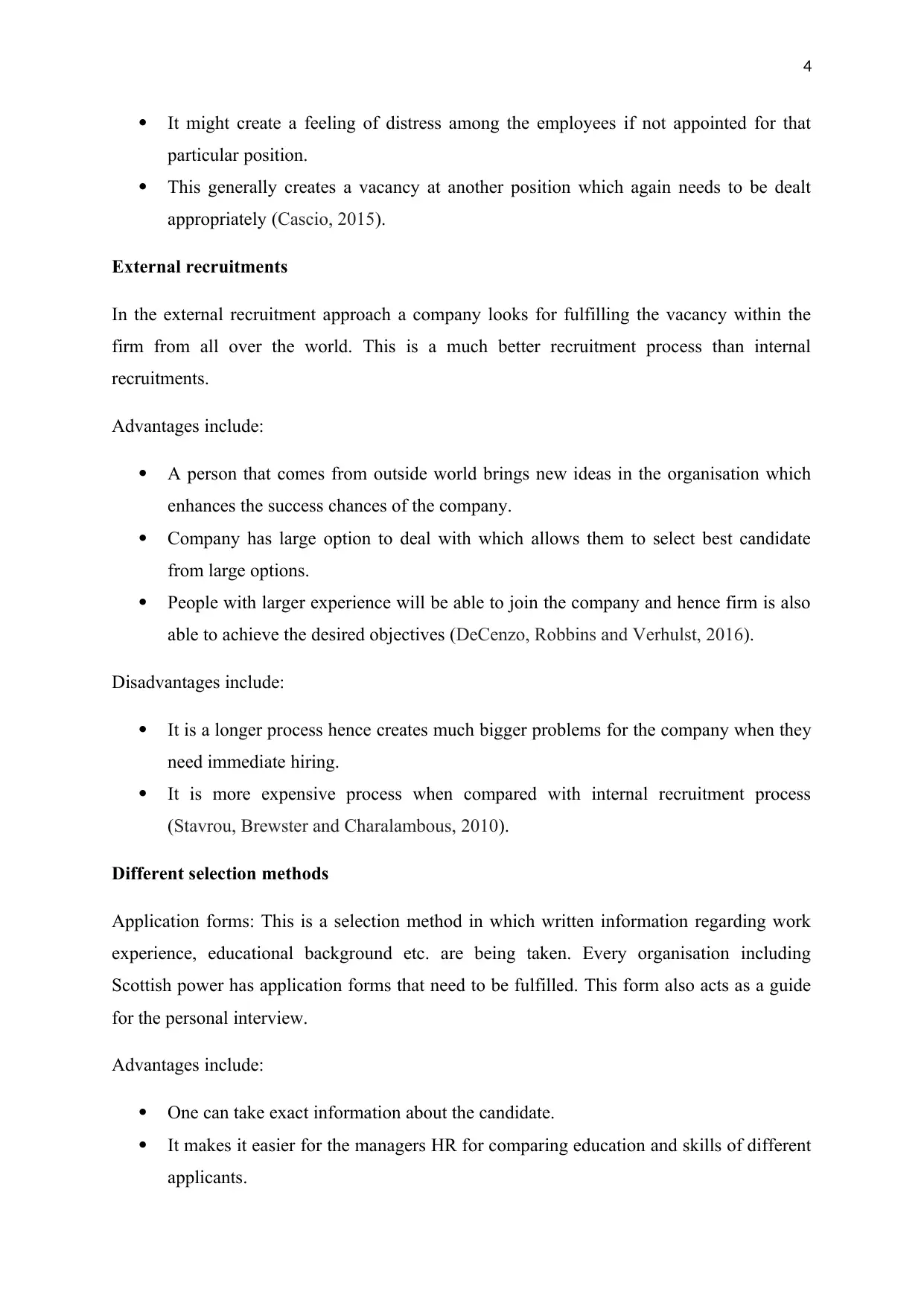
4
It might create a feeling of distress among the employees if not appointed for that
particular position.
This generally creates a vacancy at another position which again needs to be dealt
appropriately (Cascio, 2015).
External recruitments
In the external recruitment approach a company looks for fulfilling the vacancy within the
firm from all over the world. This is a much better recruitment process than internal
recruitments.
Advantages include:
A person that comes from outside world brings new ideas in the organisation which
enhances the success chances of the company.
Company has large option to deal with which allows them to select best candidate
from large options.
People with larger experience will be able to join the company and hence firm is also
able to achieve the desired objectives (DeCenzo, Robbins and Verhulst, 2016).
Disadvantages include:
It is a longer process hence creates much bigger problems for the company when they
need immediate hiring.
It is more expensive process when compared with internal recruitment process
(Stavrou, Brewster and Charalambous, 2010).
Different selection methods
Application forms: This is a selection method in which written information regarding work
experience, educational background etc. are being taken. Every organisation including
Scottish power has application forms that need to be fulfilled. This form also acts as a guide
for the personal interview.
Advantages include:
One can take exact information about the candidate.
It makes it easier for the managers HR for comparing education and skills of different
applicants.
It might create a feeling of distress among the employees if not appointed for that
particular position.
This generally creates a vacancy at another position which again needs to be dealt
appropriately (Cascio, 2015).
External recruitments
In the external recruitment approach a company looks for fulfilling the vacancy within the
firm from all over the world. This is a much better recruitment process than internal
recruitments.
Advantages include:
A person that comes from outside world brings new ideas in the organisation which
enhances the success chances of the company.
Company has large option to deal with which allows them to select best candidate
from large options.
People with larger experience will be able to join the company and hence firm is also
able to achieve the desired objectives (DeCenzo, Robbins and Verhulst, 2016).
Disadvantages include:
It is a longer process hence creates much bigger problems for the company when they
need immediate hiring.
It is more expensive process when compared with internal recruitment process
(Stavrou, Brewster and Charalambous, 2010).
Different selection methods
Application forms: This is a selection method in which written information regarding work
experience, educational background etc. are being taken. Every organisation including
Scottish power has application forms that need to be fulfilled. This form also acts as a guide
for the personal interview.
Advantages include:
One can take exact information about the candidate.
It makes it easier for the managers HR for comparing education and skills of different
applicants.
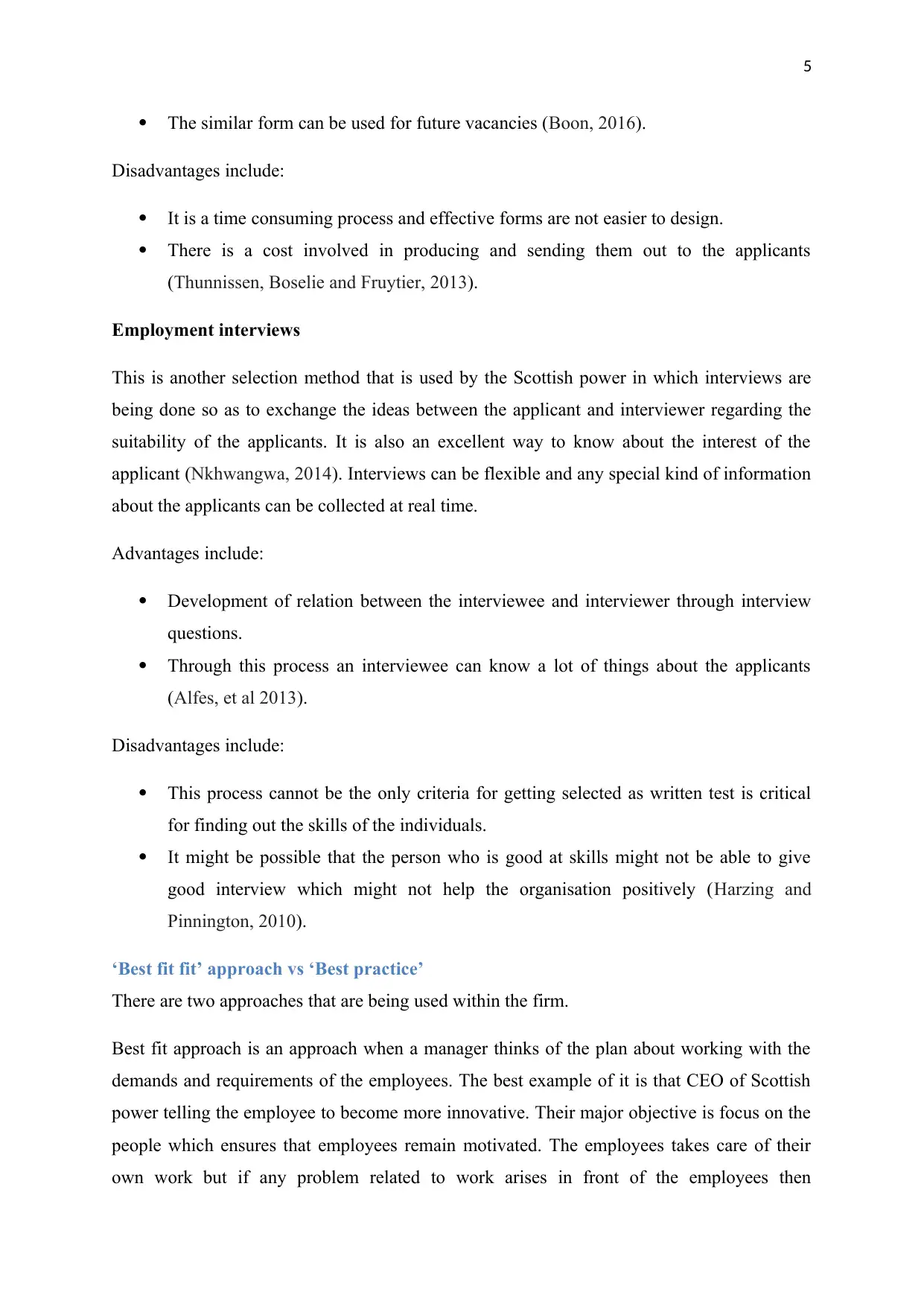
5
The similar form can be used for future vacancies (Boon, 2016).
Disadvantages include:
It is a time consuming process and effective forms are not easier to design.
There is a cost involved in producing and sending them out to the applicants
(Thunnissen, Boselie and Fruytier, 2013).
Employment interviews
This is another selection method that is used by the Scottish power in which interviews are
being done so as to exchange the ideas between the applicant and interviewer regarding the
suitability of the applicants. It is also an excellent way to know about the interest of the
applicant (Nkhwangwa, 2014). Interviews can be flexible and any special kind of information
about the applicants can be collected at real time.
Advantages include:
Development of relation between the interviewee and interviewer through interview
questions.
Through this process an interviewee can know a lot of things about the applicants
(Alfes, et al 2013).
Disadvantages include:
This process cannot be the only criteria for getting selected as written test is critical
for finding out the skills of the individuals.
It might be possible that the person who is good at skills might not be able to give
good interview which might not help the organisation positively (Harzing and
Pinnington, 2010).
‘Best fit fit’ approach vs ‘Best practice’
There are two approaches that are being used within the firm.
Best fit approach is an approach when a manager thinks of the plan about working with the
demands and requirements of the employees. The best example of it is that CEO of Scottish
power telling the employee to become more innovative. Their major objective is focus on the
people which ensures that employees remain motivated. The employees takes care of their
own work but if any problem related to work arises in front of the employees then
The similar form can be used for future vacancies (Boon, 2016).
Disadvantages include:
It is a time consuming process and effective forms are not easier to design.
There is a cost involved in producing and sending them out to the applicants
(Thunnissen, Boselie and Fruytier, 2013).
Employment interviews
This is another selection method that is used by the Scottish power in which interviews are
being done so as to exchange the ideas between the applicant and interviewer regarding the
suitability of the applicants. It is also an excellent way to know about the interest of the
applicant (Nkhwangwa, 2014). Interviews can be flexible and any special kind of information
about the applicants can be collected at real time.
Advantages include:
Development of relation between the interviewee and interviewer through interview
questions.
Through this process an interviewee can know a lot of things about the applicants
(Alfes, et al 2013).
Disadvantages include:
This process cannot be the only criteria for getting selected as written test is critical
for finding out the skills of the individuals.
It might be possible that the person who is good at skills might not be able to give
good interview which might not help the organisation positively (Harzing and
Pinnington, 2010).
‘Best fit fit’ approach vs ‘Best practice’
There are two approaches that are being used within the firm.
Best fit approach is an approach when a manager thinks of the plan about working with the
demands and requirements of the employees. The best example of it is that CEO of Scottish
power telling the employee to become more innovative. Their major objective is focus on the
people which ensures that employees remain motivated. The employees takes care of their
own work but if any problem related to work arises in front of the employees then
⊘ This is a preview!⊘
Do you want full access?
Subscribe today to unlock all pages.

Trusted by 1+ million students worldwide
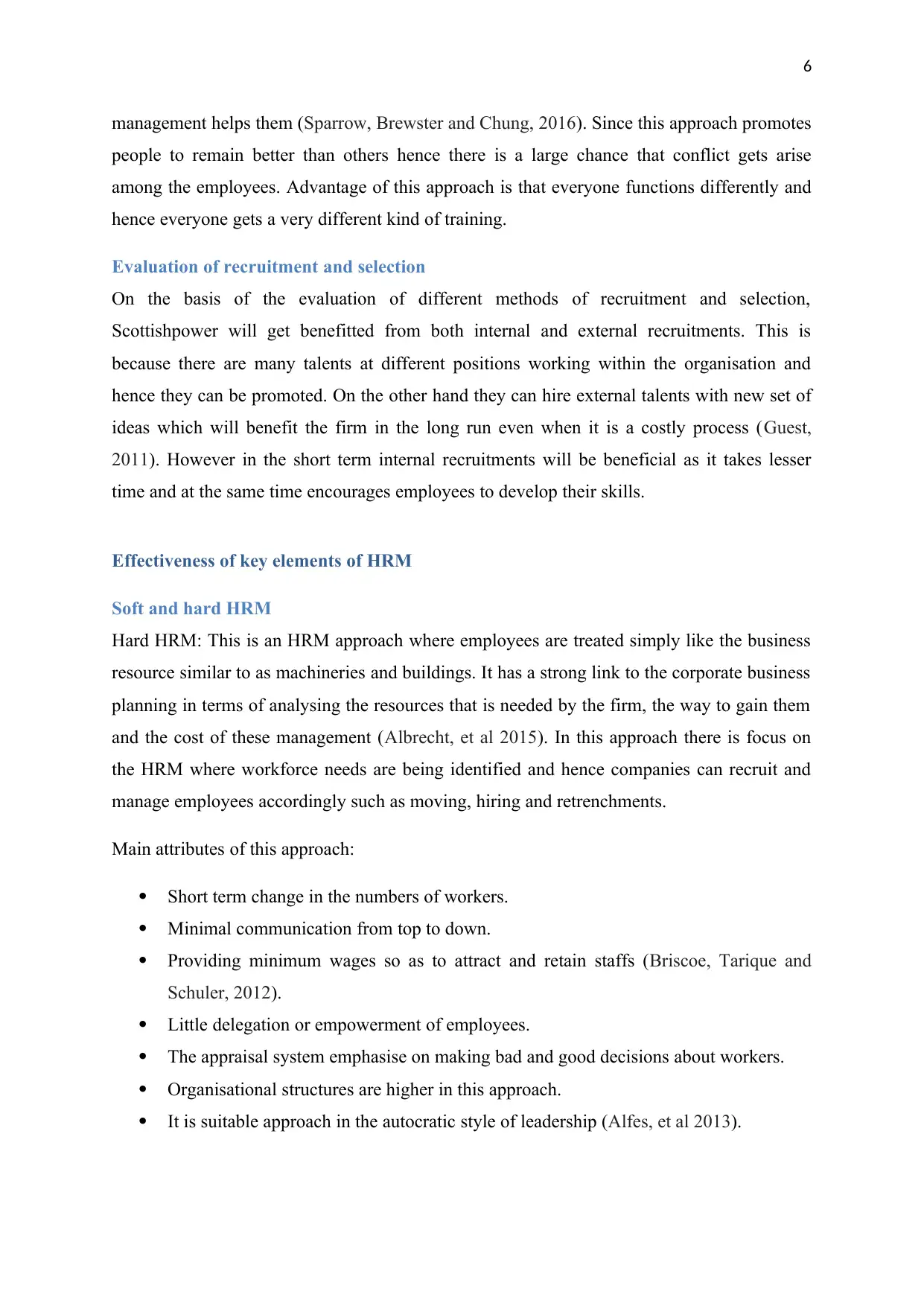
6
management helps them (Sparrow, Brewster and Chung, 2016). Since this approach promotes
people to remain better than others hence there is a large chance that conflict gets arise
among the employees. Advantage of this approach is that everyone functions differently and
hence everyone gets a very different kind of training.
Evaluation of recruitment and selection
On the basis of the evaluation of different methods of recruitment and selection,
Scottishpower will get benefitted from both internal and external recruitments. This is
because there are many talents at different positions working within the organisation and
hence they can be promoted. On the other hand they can hire external talents with new set of
ideas which will benefit the firm in the long run even when it is a costly process (Guest,
2011). However in the short term internal recruitments will be beneficial as it takes lesser
time and at the same time encourages employees to develop their skills.
Effectiveness of key elements of HRM
Soft and hard HRM
Hard HRM: This is an HRM approach where employees are treated simply like the business
resource similar to as machineries and buildings. It has a strong link to the corporate business
planning in terms of analysing the resources that is needed by the firm, the way to gain them
and the cost of these management (Albrecht, et al 2015). In this approach there is focus on
the HRM where workforce needs are being identified and hence companies can recruit and
manage employees accordingly such as moving, hiring and retrenchments.
Main attributes of this approach:
Short term change in the numbers of workers.
Minimal communication from top to down.
Providing minimum wages so as to attract and retain staffs (Briscoe, Tarique and
Schuler, 2012).
Little delegation or empowerment of employees.
The appraisal system emphasise on making bad and good decisions about workers.
Organisational structures are higher in this approach.
It is suitable approach in the autocratic style of leadership (Alfes, et al 2013).
management helps them (Sparrow, Brewster and Chung, 2016). Since this approach promotes
people to remain better than others hence there is a large chance that conflict gets arise
among the employees. Advantage of this approach is that everyone functions differently and
hence everyone gets a very different kind of training.
Evaluation of recruitment and selection
On the basis of the evaluation of different methods of recruitment and selection,
Scottishpower will get benefitted from both internal and external recruitments. This is
because there are many talents at different positions working within the organisation and
hence they can be promoted. On the other hand they can hire external talents with new set of
ideas which will benefit the firm in the long run even when it is a costly process (Guest,
2011). However in the short term internal recruitments will be beneficial as it takes lesser
time and at the same time encourages employees to develop their skills.
Effectiveness of key elements of HRM
Soft and hard HRM
Hard HRM: This is an HRM approach where employees are treated simply like the business
resource similar to as machineries and buildings. It has a strong link to the corporate business
planning in terms of analysing the resources that is needed by the firm, the way to gain them
and the cost of these management (Albrecht, et al 2015). In this approach there is focus on
the HRM where workforce needs are being identified and hence companies can recruit and
manage employees accordingly such as moving, hiring and retrenchments.
Main attributes of this approach:
Short term change in the numbers of workers.
Minimal communication from top to down.
Providing minimum wages so as to attract and retain staffs (Briscoe, Tarique and
Schuler, 2012).
Little delegation or empowerment of employees.
The appraisal system emphasise on making bad and good decisions about workers.
Organisational structures are higher in this approach.
It is suitable approach in the autocratic style of leadership (Alfes, et al 2013).
Paraphrase This Document
Need a fresh take? Get an instant paraphrase of this document with our AI Paraphraser
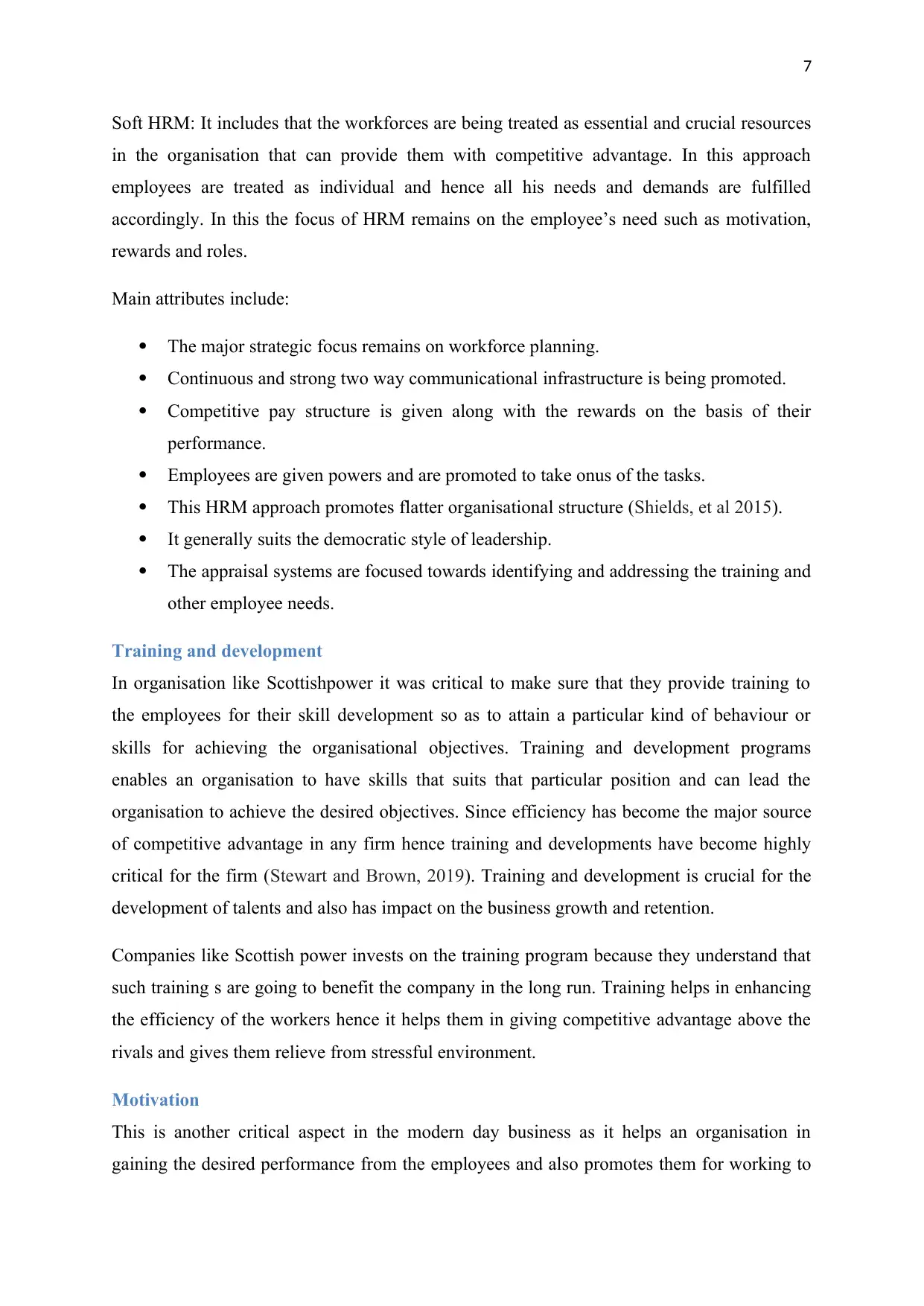
7
Soft HRM: It includes that the workforces are being treated as essential and crucial resources
in the organisation that can provide them with competitive advantage. In this approach
employees are treated as individual and hence all his needs and demands are fulfilled
accordingly. In this the focus of HRM remains on the employee’s need such as motivation,
rewards and roles.
Main attributes include:
The major strategic focus remains on workforce planning.
Continuous and strong two way communicational infrastructure is being promoted.
Competitive pay structure is given along with the rewards on the basis of their
performance.
Employees are given powers and are promoted to take onus of the tasks.
This HRM approach promotes flatter organisational structure (Shields, et al 2015).
It generally suits the democratic style of leadership.
The appraisal systems are focused towards identifying and addressing the training and
other employee needs.
Training and development
In organisation like Scottishpower it was critical to make sure that they provide training to
the employees for their skill development so as to attain a particular kind of behaviour or
skills for achieving the organisational objectives. Training and development programs
enables an organisation to have skills that suits that particular position and can lead the
organisation to achieve the desired objectives. Since efficiency has become the major source
of competitive advantage in any firm hence training and developments have become highly
critical for the firm (Stewart and Brown, 2019). Training and development is crucial for the
development of talents and also has impact on the business growth and retention.
Companies like Scottish power invests on the training program because they understand that
such training s are going to benefit the company in the long run. Training helps in enhancing
the efficiency of the workers hence it helps them in giving competitive advantage above the
rivals and gives them relieve from stressful environment.
Motivation
This is another critical aspect in the modern day business as it helps an organisation in
gaining the desired performance from the employees and also promotes them for working to
Soft HRM: It includes that the workforces are being treated as essential and crucial resources
in the organisation that can provide them with competitive advantage. In this approach
employees are treated as individual and hence all his needs and demands are fulfilled
accordingly. In this the focus of HRM remains on the employee’s need such as motivation,
rewards and roles.
Main attributes include:
The major strategic focus remains on workforce planning.
Continuous and strong two way communicational infrastructure is being promoted.
Competitive pay structure is given along with the rewards on the basis of their
performance.
Employees are given powers and are promoted to take onus of the tasks.
This HRM approach promotes flatter organisational structure (Shields, et al 2015).
It generally suits the democratic style of leadership.
The appraisal systems are focused towards identifying and addressing the training and
other employee needs.
Training and development
In organisation like Scottishpower it was critical to make sure that they provide training to
the employees for their skill development so as to attain a particular kind of behaviour or
skills for achieving the organisational objectives. Training and development programs
enables an organisation to have skills that suits that particular position and can lead the
organisation to achieve the desired objectives. Since efficiency has become the major source
of competitive advantage in any firm hence training and developments have become highly
critical for the firm (Stewart and Brown, 2019). Training and development is crucial for the
development of talents and also has impact on the business growth and retention.
Companies like Scottish power invests on the training program because they understand that
such training s are going to benefit the company in the long run. Training helps in enhancing
the efficiency of the workers hence it helps them in giving competitive advantage above the
rivals and gives them relieve from stressful environment.
Motivation
This is another critical aspect in the modern day business as it helps an organisation in
gaining the desired performance from the employees and also promotes them for working to
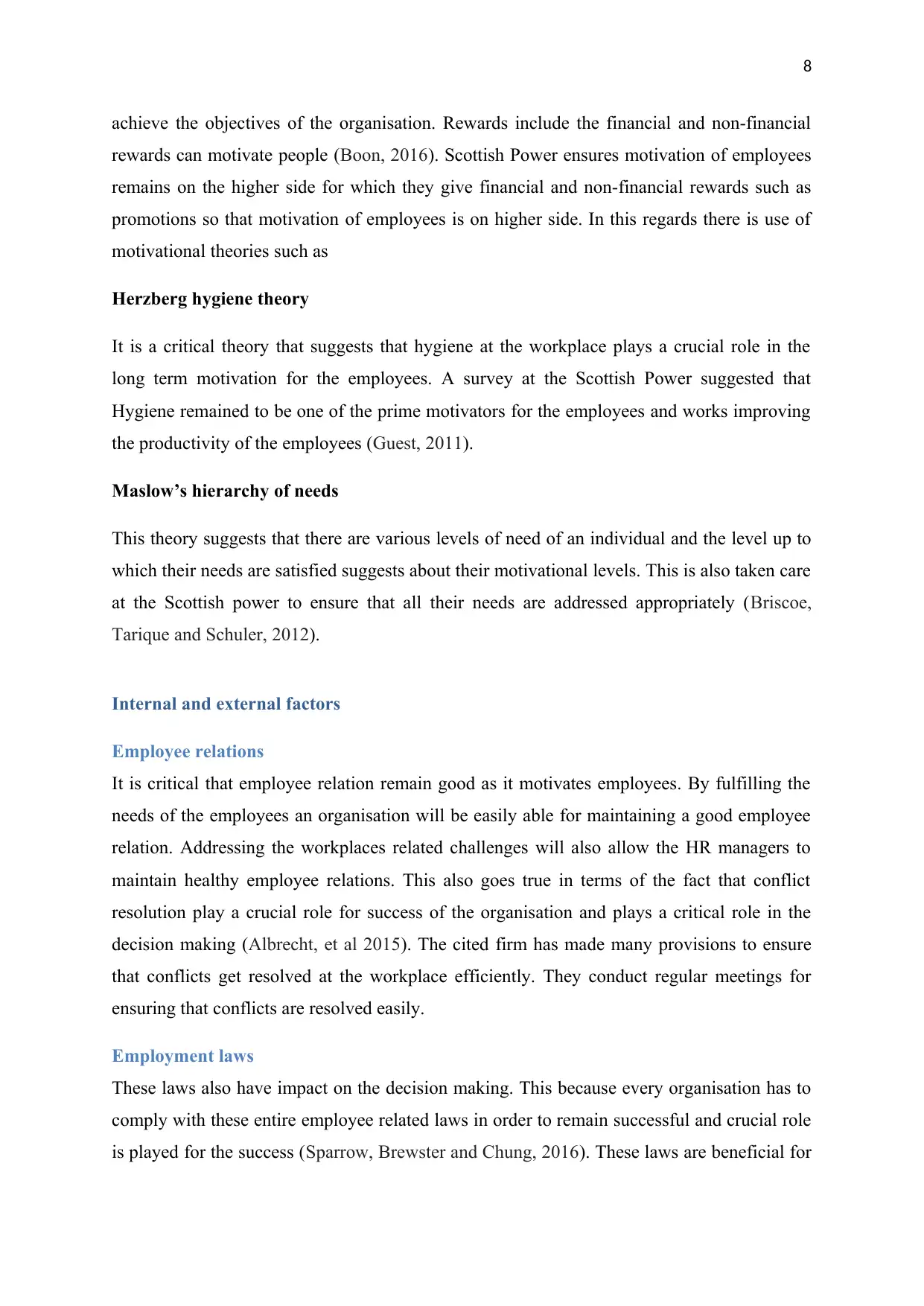
8
achieve the objectives of the organisation. Rewards include the financial and non-financial
rewards can motivate people (Boon, 2016). Scottish Power ensures motivation of employees
remains on the higher side for which they give financial and non-financial rewards such as
promotions so that motivation of employees is on higher side. In this regards there is use of
motivational theories such as
Herzberg hygiene theory
It is a critical theory that suggests that hygiene at the workplace plays a crucial role in the
long term motivation for the employees. A survey at the Scottish Power suggested that
Hygiene remained to be one of the prime motivators for the employees and works improving
the productivity of the employees (Guest, 2011).
Maslow’s hierarchy of needs
This theory suggests that there are various levels of need of an individual and the level up to
which their needs are satisfied suggests about their motivational levels. This is also taken care
at the Scottish power to ensure that all their needs are addressed appropriately (Briscoe,
Tarique and Schuler, 2012).
Internal and external factors
Employee relations
It is critical that employee relation remain good as it motivates employees. By fulfilling the
needs of the employees an organisation will be easily able for maintaining a good employee
relation. Addressing the workplaces related challenges will also allow the HR managers to
maintain healthy employee relations. This also goes true in terms of the fact that conflict
resolution play a crucial role for success of the organisation and plays a critical role in the
decision making (Albrecht, et al 2015). The cited firm has made many provisions to ensure
that conflicts get resolved at the workplace efficiently. They conduct regular meetings for
ensuring that conflicts are resolved easily.
Employment laws
These laws also have impact on the decision making. This because every organisation has to
comply with these entire employee related laws in order to remain successful and crucial role
is played for the success (Sparrow, Brewster and Chung, 2016). These laws are beneficial for
achieve the objectives of the organisation. Rewards include the financial and non-financial
rewards can motivate people (Boon, 2016). Scottish Power ensures motivation of employees
remains on the higher side for which they give financial and non-financial rewards such as
promotions so that motivation of employees is on higher side. In this regards there is use of
motivational theories such as
Herzberg hygiene theory
It is a critical theory that suggests that hygiene at the workplace plays a crucial role in the
long term motivation for the employees. A survey at the Scottish Power suggested that
Hygiene remained to be one of the prime motivators for the employees and works improving
the productivity of the employees (Guest, 2011).
Maslow’s hierarchy of needs
This theory suggests that there are various levels of need of an individual and the level up to
which their needs are satisfied suggests about their motivational levels. This is also taken care
at the Scottish power to ensure that all their needs are addressed appropriately (Briscoe,
Tarique and Schuler, 2012).
Internal and external factors
Employee relations
It is critical that employee relation remain good as it motivates employees. By fulfilling the
needs of the employees an organisation will be easily able for maintaining a good employee
relation. Addressing the workplaces related challenges will also allow the HR managers to
maintain healthy employee relations. This also goes true in terms of the fact that conflict
resolution play a crucial role for success of the organisation and plays a critical role in the
decision making (Albrecht, et al 2015). The cited firm has made many provisions to ensure
that conflicts get resolved at the workplace efficiently. They conduct regular meetings for
ensuring that conflicts are resolved easily.
Employment laws
These laws also have impact on the decision making. This because every organisation has to
comply with these entire employee related laws in order to remain successful and crucial role
is played for the success (Sparrow, Brewster and Chung, 2016). These laws are beneficial for
⊘ This is a preview!⊘
Do you want full access?
Subscribe today to unlock all pages.

Trusted by 1+ million students worldwide
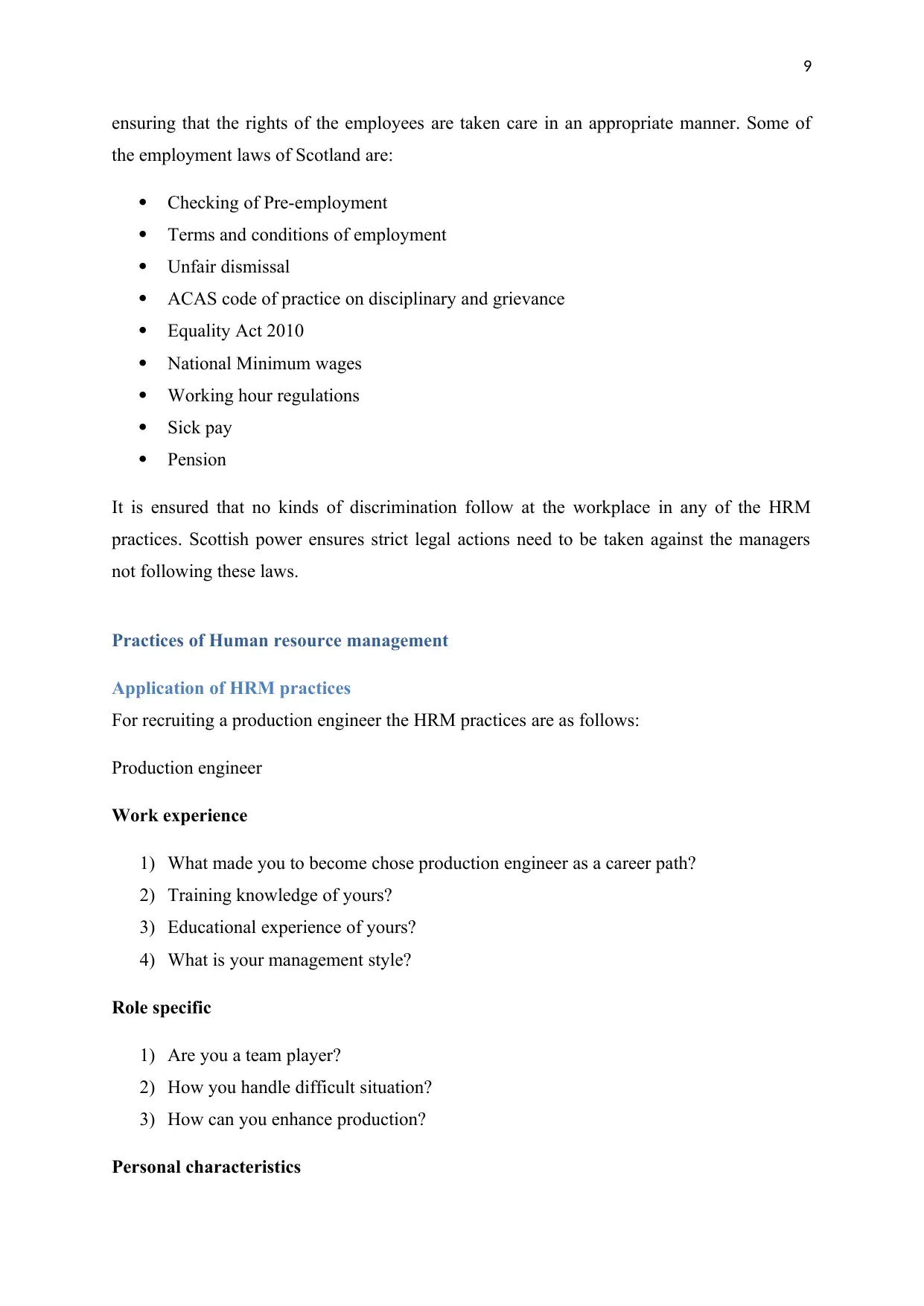
9
ensuring that the rights of the employees are taken care in an appropriate manner. Some of
the employment laws of Scotland are:
Checking of Pre-employment
Terms and conditions of employment
Unfair dismissal
ACAS code of practice on disciplinary and grievance
Equality Act 2010
National Minimum wages
Working hour regulations
Sick pay
Pension
It is ensured that no kinds of discrimination follow at the workplace in any of the HRM
practices. Scottish power ensures strict legal actions need to be taken against the managers
not following these laws.
Practices of Human resource management
Application of HRM practices
For recruiting a production engineer the HRM practices are as follows:
Production engineer
Work experience
1) What made you to become chose production engineer as a career path?
2) Training knowledge of yours?
3) Educational experience of yours?
4) What is your management style?
Role specific
1) Are you a team player?
2) How you handle difficult situation?
3) How can you enhance production?
Personal characteristics
ensuring that the rights of the employees are taken care in an appropriate manner. Some of
the employment laws of Scotland are:
Checking of Pre-employment
Terms and conditions of employment
Unfair dismissal
ACAS code of practice on disciplinary and grievance
Equality Act 2010
National Minimum wages
Working hour regulations
Sick pay
Pension
It is ensured that no kinds of discrimination follow at the workplace in any of the HRM
practices. Scottish power ensures strict legal actions need to be taken against the managers
not following these laws.
Practices of Human resource management
Application of HRM practices
For recruiting a production engineer the HRM practices are as follows:
Production engineer
Work experience
1) What made you to become chose production engineer as a career path?
2) Training knowledge of yours?
3) Educational experience of yours?
4) What is your management style?
Role specific
1) Are you a team player?
2) How you handle difficult situation?
3) How can you enhance production?
Personal characteristics
Paraphrase This Document
Need a fresh take? Get an instant paraphrase of this document with our AI Paraphraser
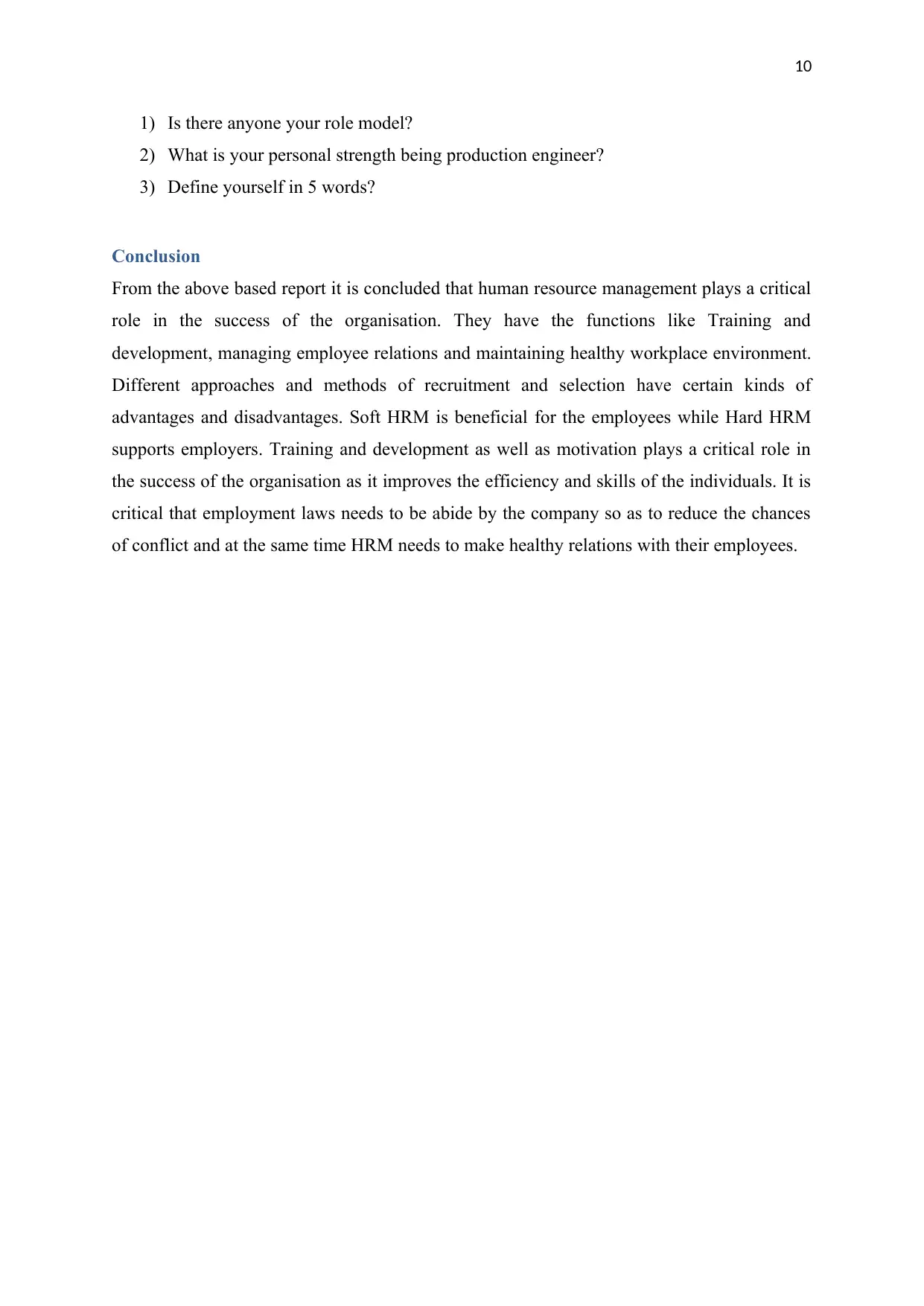
10
1) Is there anyone your role model?
2) What is your personal strength being production engineer?
3) Define yourself in 5 words?
Conclusion
From the above based report it is concluded that human resource management plays a critical
role in the success of the organisation. They have the functions like Training and
development, managing employee relations and maintaining healthy workplace environment.
Different approaches and methods of recruitment and selection have certain kinds of
advantages and disadvantages. Soft HRM is beneficial for the employees while Hard HRM
supports employers. Training and development as well as motivation plays a critical role in
the success of the organisation as it improves the efficiency and skills of the individuals. It is
critical that employment laws needs to be abide by the company so as to reduce the chances
of conflict and at the same time HRM needs to make healthy relations with their employees.
1) Is there anyone your role model?
2) What is your personal strength being production engineer?
3) Define yourself in 5 words?
Conclusion
From the above based report it is concluded that human resource management plays a critical
role in the success of the organisation. They have the functions like Training and
development, managing employee relations and maintaining healthy workplace environment.
Different approaches and methods of recruitment and selection have certain kinds of
advantages and disadvantages. Soft HRM is beneficial for the employees while Hard HRM
supports employers. Training and development as well as motivation plays a critical role in
the success of the organisation as it improves the efficiency and skills of the individuals. It is
critical that employment laws needs to be abide by the company so as to reduce the chances
of conflict and at the same time HRM needs to make healthy relations with their employees.
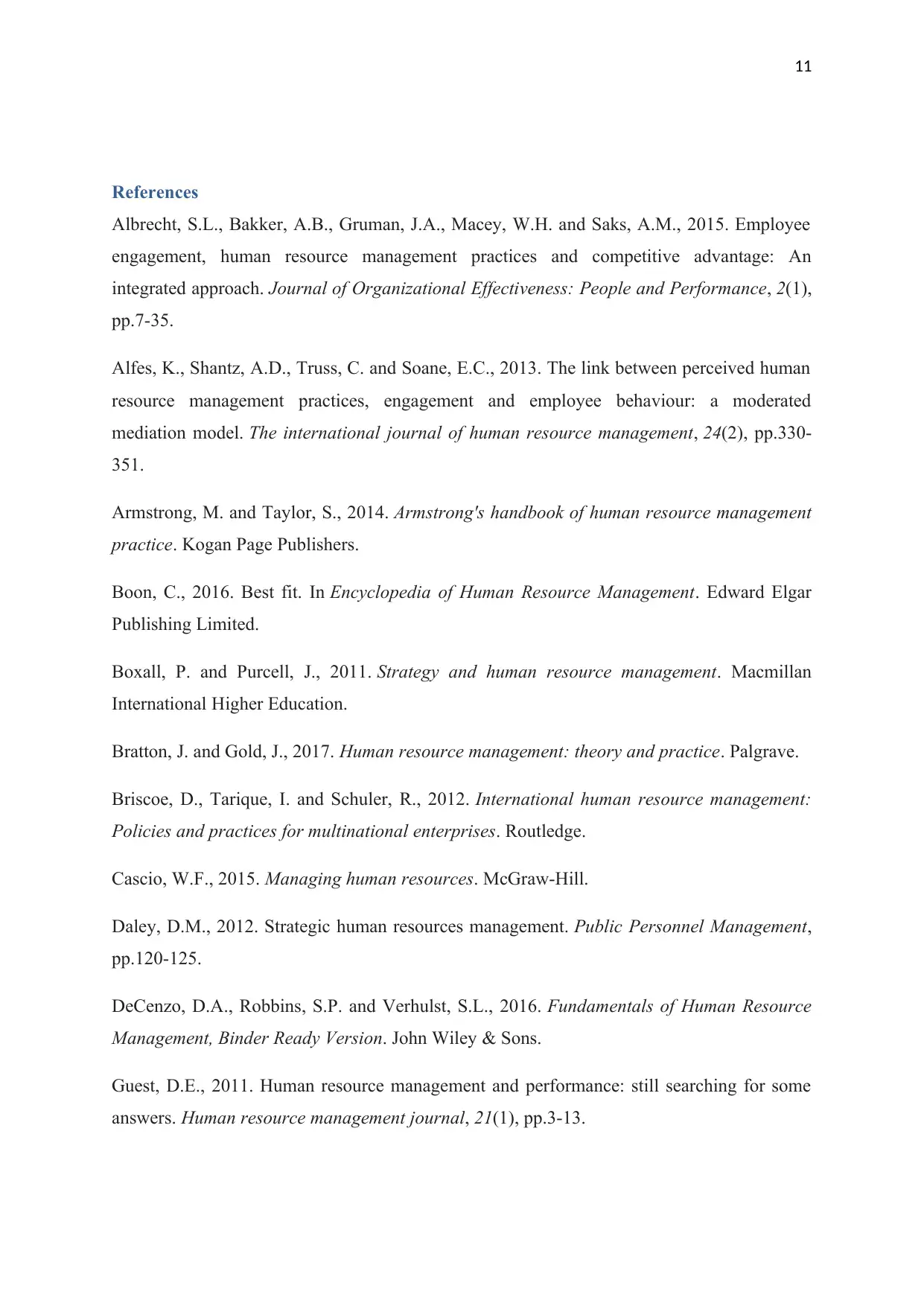
11
References
Albrecht, S.L., Bakker, A.B., Gruman, J.A., Macey, W.H. and Saks, A.M., 2015. Employee
engagement, human resource management practices and competitive advantage: An
integrated approach. Journal of Organizational Effectiveness: People and Performance, 2(1),
pp.7-35.
Alfes, K., Shantz, A.D., Truss, C. and Soane, E.C., 2013. The link between perceived human
resource management practices, engagement and employee behaviour: a moderated
mediation model. The international journal of human resource management, 24(2), pp.330-
351.
Armstrong, M. and Taylor, S., 2014. Armstrong's handbook of human resource management
practice. Kogan Page Publishers.
Boon, C., 2016. Best fit. In Encyclopedia of Human Resource Management. Edward Elgar
Publishing Limited.
Boxall, P. and Purcell, J., 2011. Strategy and human resource management. Macmillan
International Higher Education.
Bratton, J. and Gold, J., 2017. Human resource management: theory and practice. Palgrave.
Briscoe, D., Tarique, I. and Schuler, R., 2012. International human resource management:
Policies and practices for multinational enterprises. Routledge.
Cascio, W.F., 2015. Managing human resources. McGraw-Hill.
Daley, D.M., 2012. Strategic human resources management. Public Personnel Management,
pp.120-125.
DeCenzo, D.A., Robbins, S.P. and Verhulst, S.L., 2016. Fundamentals of Human Resource
Management, Binder Ready Version. John Wiley & Sons.
Guest, D.E., 2011. Human resource management and performance: still searching for some
answers. Human resource management journal, 21(1), pp.3-13.
References
Albrecht, S.L., Bakker, A.B., Gruman, J.A., Macey, W.H. and Saks, A.M., 2015. Employee
engagement, human resource management practices and competitive advantage: An
integrated approach. Journal of Organizational Effectiveness: People and Performance, 2(1),
pp.7-35.
Alfes, K., Shantz, A.D., Truss, C. and Soane, E.C., 2013. The link between perceived human
resource management practices, engagement and employee behaviour: a moderated
mediation model. The international journal of human resource management, 24(2), pp.330-
351.
Armstrong, M. and Taylor, S., 2014. Armstrong's handbook of human resource management
practice. Kogan Page Publishers.
Boon, C., 2016. Best fit. In Encyclopedia of Human Resource Management. Edward Elgar
Publishing Limited.
Boxall, P. and Purcell, J., 2011. Strategy and human resource management. Macmillan
International Higher Education.
Bratton, J. and Gold, J., 2017. Human resource management: theory and practice. Palgrave.
Briscoe, D., Tarique, I. and Schuler, R., 2012. International human resource management:
Policies and practices for multinational enterprises. Routledge.
Cascio, W.F., 2015. Managing human resources. McGraw-Hill.
Daley, D.M., 2012. Strategic human resources management. Public Personnel Management,
pp.120-125.
DeCenzo, D.A., Robbins, S.P. and Verhulst, S.L., 2016. Fundamentals of Human Resource
Management, Binder Ready Version. John Wiley & Sons.
Guest, D.E., 2011. Human resource management and performance: still searching for some
answers. Human resource management journal, 21(1), pp.3-13.
⊘ This is a preview!⊘
Do you want full access?
Subscribe today to unlock all pages.

Trusted by 1+ million students worldwide
1 out of 13
Related Documents
Your All-in-One AI-Powered Toolkit for Academic Success.
+13062052269
info@desklib.com
Available 24*7 on WhatsApp / Email
![[object Object]](/_next/static/media/star-bottom.7253800d.svg)
Unlock your academic potential
Copyright © 2020–2025 A2Z Services. All Rights Reserved. Developed and managed by ZUCOL.



